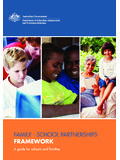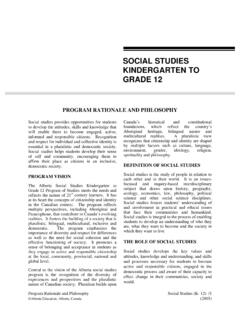Transcription of Review Long-term effects of bullying - Archives of Disease ...
1 Long-term effects of bullyingDieter Wolke,1 Suzet Tanya Lereya21 Department of Psychology andDivision of Mental Health andWellbeing, University ofWarwick, Coventry, UK2 Department of Psychology,University of Warwick,Coventry, UKCorrespondence toProfessor Dieter Wolke,Department of Psychology,University of Warwick,Coventry, CV4 7AL, 25 November 2014 Revised 6 January 2015 Accepted 18 January 2015 Published Online First10 February 2015To cite:Wolke D, Lereya Dis Child2015;100:879 is the systematic abuse of power and is definedas aggressive behaviour or intentional harm-doing bypeers that is carried out repeatedly and involves animbalance of power. Being bullied is still often wronglyconsidered as a normal rite of passage . This reviewconsiders the importance of bullying as a major riskfactor for poor physical and mental health and reducedadaptation to adult roles including forming lastingrelationships, integrating into work and beingeconomically independent.
2 bullying by peers has beenmostly ignored by health professionals but shouldbe considered as a significant risk factor andsafeguarding AND EPIDEMIOLOGYB ullying is the systematic abuse of power and isdefined as aggressive behaviour orintentional harm-doingby peers that is carried outrepeatedlyandinvolvesan imbalance of power, either actual or per-ceived, between the victim and the take the form of direct bullying , which includesphysical and verbal acts of aggression such ashitting, stealing or name calling, or indirect bullying ,which is characterised by social exclusion (eg, youcannot play with us, you are not invited, etc) andrumour 4 Children can be involved inbullying as victims and bullies, and also as bully/victims, a subgroup of victims who also displaybullying there has been muchinterest in cyberbullying, which can be broadlydefined as any bullying which is performed via elec-tronic means, such as mobile phones or the in three children report having been bullied atsome point in their lives, and 10 14% experiencechronic bullying lasting for more than 6 2% and 5% are bullies and a similarnumber are bully/victims in of cyberbullying are substantially lower ataround for victims and for perpetrators(bullies and bully/victims), with up to 90% of thecyber- bullying victims also being traditionally (faceto face)
3 Bullied by peers is the mostfrequent form of abuse encountered by children,much higher than abuse by parents or other adultperpetrators11(box 1). bullying IS NOT CONDUCT DISORDERB ullying is found in all societies, including modernhunter-gatherer societies and ancient civilisations. Itis considered an evolutionary adaptation, thepurpose of which is to gain high status and domin-ance,14get access to resources, secure survival,reduce stress and allow for more mating are often bi-strategic, employingboth bullying and also acts of aggressive prosocial behaviour to enhance their own position by actingin public and making the recipient dependent asthey cannot , pure bullies (butnot bully/victims or victims) have been found to bestrong, highly popular and to have good social andemotional , bullies mostlikely do not have a conduct disorder.
4 Moreover,unlike conduct disorder, bullies are found in allsocioeconomic18and ethnic contrast,victims have been described as withdrawn,unassertive, easily emotionally upset, and as havingpoor emotional or social understanding,17 19whilebully/victims tend to be aggressive, easily angered,low on popularity, frequently bullied by their sib-lings20and come from families with lower socio-economic status (SES),18similar to children withconduct BULLIES OPERATEB ullying occurs in settings where individuals do nothave a say concerning the group they want to be is the situation for children in school class-rooms or at home with siblings, and has been com-pared to being caged with others. In an effort toestablish a social network or hierarchy, bullies willtry to exert their power with all children. Thosewho have an emotional reaction (eg, cry, run away,are upset) and have nobody or few to stand up forthem, are the repeated targets of bullies.
5 Bulliesmay get others to join in (laugh, tease, hit, spreadrumours) as bystanders or even as henchmen (bully/victims). It has been shown that conditions thatfoster higher density and greater hierarchies inclassrooms (inegalitarian conditions),21at home22or even in nations,23increase bullying24and thestability of bullying victimisation over CONSEQUENCES OF BEING BULLIEDU ntil fairly recently, most studies on the effects ofbullying were cross-sectional or just included brieffollow-up periods, making it impossible to identifywhether bullying is the cause or consequence ofhealth problems. Thus, this Review focuses mostlyon prospective studies that were able to control forpre-existing health conditions, family situation andother exposures to violence (eg, family violence) ininvestigating the effects of being involved in bully-ing on subsequent health, self-harm and suicide,schooling, employment and social AND ADOLESCENCE(6 17 YEARS)A fully referenced summary of the consequences ofbullying during childhood and adolescence on pro-spectively studied outcomes up to the age of17 years is shown intable 1.
6 Children who werevictims of bullying have been consistently found tobe at higher risk for common somatic problemssuch as colds, or psychosomatic problems such asOpenAccessScantoaccessmorefreecontentW olke D, Lereya Dis Child2015;100:879 885. on January 20, 2022 by guest. Protected by Dis Child: first published as on 10 February 2015. Downloaded from headaches, stomach aches or sleeping problems, and are morelikely to take up 40 Victims have also been reportedto more often develop internalising problems and anxiety dis-order or depression sensitive designsallowed comparison of monozygotic twins who are geneticallyidentical and live in the same households but were discordantfor experiences of bullying . Internalising problems was found tohave increased over time only in those who were bullied,32pro-viding strong evidence that bullying rather than other factorsexplains increases in internalising problems.
7 Furthermore,victims of bullying are at significantly increased risk of self-harmor thinking about suicide in 44 Furthermore,being bullied in primary school has been found to both predictborderline personality symptoms30and psychotic experiences,such as hallucinations or delusions, by , those who were either exposed to several forms ofbullying or were bullied over long periods of time (chronicbullying) tended to show more adverse 37In contrastto the consistently moderate to strong relationships withsomatic and mental health outcomes, the association betweenbeing bullied and poor academic functioning has not been asstrong as meta-analysis only indicated a smallnegative effect of victimisation on mostly concurrent academicperformance and the effects differed whether bullying was self-reported or by peers or studies that distin-guished between victims and bully/victims usually reported thatbully/victims had a slightly higher risk for somatic and mentalhealth problems than pure 52 Furthermore, moststudies considered bullies and bully/victims together.
8 However,as outlined above, the two roles are quite different with bulliesoften highly competent manipulators and ringleaders, whilebully/victims are described as impulsive and poor in regulatingtheir know little about the mental health out-comes of bullies in childhood, but there are some suggestionsthat they may also be at slightly increased risk of depression orself-harm,33 45however, less so than victims. Similarly, the rela-tionship between being a bully and somatic health is weakerthan in bully/victims,39or bullies have even been found to behealthier and stronger than children not involved in perpetration has been found to increase the risk ofoffending in adolescence;54however, the analysis did not distin-guish between bullies and bully/victims and did not includeinformation about poly-victimisation (eg, being maltreated byparents).
9 Bullies were also more likely to display delinquentbehaviour and perpetrate dating violence by eighth TO ADULTHOOD (18 50 YEARS)Children who were victims of bullying have been consistentlyfound to be at higher risk for internalising problems, in particu-lar diagnoses of anxiety disorder55and depression9in youngadulthood and middle adulthood (18 50 years of age)(table 2).56 Furthermore, victims were at increased risk for dis-playing psychotic experiences at age 188and having suicidalideation, attempts and completed were alsoreported to have poor general health,65including more bodilypain, headaches and slower recovery from ,victimised children were found to have lower educational quali-fications, be worse atfinancial management57and to earn lessthan their peers even at age 69 Victims were also reportedto have more trouble making or keeping friends and to be lesslikely to live with a partner and have social support.
10 No associ-ation between substance use, anti-social behaviour and victimisa-tion was found. The studies that distinguished between victimsand bully/victims showed that usually bully/victims had a slightlyhigher risk for anxiety, depression, psychotic experiences,suicide attempts and poor general health than pure also had even lower educational qualifications and troublekeeping a job and honouringfinancial 65In con-trast to pure victims, bully/victims were at increased risk for dis-playing anti-social behaviour and were more likely to become ayoung 70 71 Again, we know less about pure bullies,but where studied, they were not found to be at increased riskfor any mental or general health problems. Indeed, they werehealthier than their peers, emotionally and , pure bullies may be more deviant and more likely toBox 1 bullying bullyingrefers to harming others by directly getting atthem.











